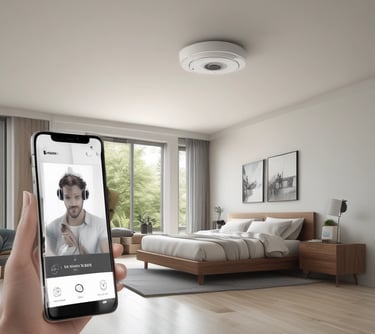

Some seniors may stay in place and add smart home devices while other seniors are considering other options. Here we go over a few senior transition options.
Embracing the Change and Journey Towards Transition
The decision to transition from a long-time family home to a new living arrangement is one of the most emotionally complex and logistically challenging choices seniors and their families face. Whether prompted by health concerns, financial realities, or the desire for simplicity, this transition marks the beginning of a new chapter—one that can be both daunting and liberating.
Here we dive into understanding why change is necessary, how to approach it with empathy, and what tools you’ll need to navigate the journey ahead. Think of it as a roadmap for embracing uncertainty with courage and clarity.
Change Is Inevitable and it’s Okay.
1. The Reality of Aging
Physical Limitations: Stairs become tripping hazards. Maintenance chores grow exhausting. Driving may no longer feel safe.
Social Isolation: Empty nests, loss of friends, or dwindling community ties can lead to loneliness.
Financial Pressures: A large home’s upkeep (property taxes, repairs) may no longer align with fixed incomes.
2. The Gift of Reinvention
Transitioning isn’t about loss—it’s about creating space for what matters most:
Safety and accessibility
Social engagement (senior communities)
Freedom from burdensome responsibilities
Key Message: This isn’t an ending—it’s a pivot toward intentional living.
An Emotional Landscape: Fear, Guilt, and Hope
For Seniors:
Fear of the Unknown: “Will I lose my independence?”
Grief Over Letting Go: Sentimental attachments to homes, memories, and possessions.
Resistance: “I’ve lived here 40 years—why change now?”
For Families:
Guilt: “Am I forcing Mom into this?”
Overwhelm: Balancing parental wishes with practical realities.
Conflict: Siblings disagreeing on the “right” path.
A Fictional Story to Humanize the Struggle:
Joanne, 78, sits in her comfy lazy boy chair, staring at the “For Sale” sign in her front yard. Her daughter, Monica, gently reminds her that the two-story home is too much to manage after her hip replacement. Joanne’s eyes fill with tears as she looks around her home. Monica gives her mom a hug and says: “We’re not leaving you behind, Mom. We’re bringing your life forward.”
How to Start the Conversation with a Senior Parent(s)
1. Begin with Empathy
Avoid: “You need to move—the stairs are dangerous.”
Try: “I want you to feel safe and happy. Let’s explore options together.”
2. Ask Open-Ended Questions
“What does your ideal day look like in 5 years?”
“What parts of your current home feel overwhelming?”
3. Share others Stories
Share stories of others who’ve thrived post-transition (e.g., a neighbor who joined a reading club in their senior community).
Key Questions to Ask Yourself (or Your Loved One)
Emotional Readiness:
Am I holding onto this home out of love or fear?
Practical Realities:
Can I afford to maintain this home? Do I have support?
Future-Proofing:
What happens if I can no longer do what I love, drive or cook?
Legacy:
What do I want to pass on to my family?
Seeing the Signs of When It’s Time to Make a Change
Change often begins with subtle signs—a missed step here, a forgotten bill there. But how do you distinguish between normal aging and signals that it’s time to rethink your living situation? Let’s identify physical, emotional, and practical red flags while offering compassionate strategies to address them. Knowledge is power, and awareness is the first step toward empowerment.
Physical Health Indicators
1. Mobility Challenges
Difficulty climbing stairs, getting in/out of the shower, or navigating cluttered rooms.
Frequent near-falls or reliance on furniture for balance (“wall-walking”).
2. Chronic Health Conditions
Managing multiple medications becomes overwhelming.
Fatigue from routine tasks (laundry, cooking).
Checklist: Is Your Home Safe?
Bathrooms lack grab bars or non-slip mats.
Doorways are too narrow for walkers/wheelchairs.
Essential rooms (bedroom, bathroom) are on different floors.
Cognitive and Mental Health Red Flags
1. Memory Lapses
Missed appointments, unpaid bills, or spoiled food in the fridge.
Story: Sally, 79, forgot to turn off the stove twice in a month. Her son installed smart smoke detectors but realized she needed daily check-ins.
2. Depression or Anxiety
Withdrawal from hobbies, irritability, or changes in sleep patterns.
Expert Insight from a geriatric psychiatrist:
“Isolation is a silent killer. A move to a community with social activities can reignite joy.”
Social and Emotional Warning Signs
1. Loneliness
Loss of a spouse, friends moving away, or inability to drive to gatherings.
Story: After her husband died, Wilma, 82, spent weeks alone watching TV. Her grandson encouraged her to tour a senior community, where she rediscovered her love of painting.
2. Caregiver Burnout
Family members are overwhelmed by coordinating care, meals, or transportation.
If 80% of family calls are about logistics, it’s time to explore supportive housing.
Home Safety Risks
1. Maintenance Neglect
Overgrown yards, broken appliances, or ignored repairs.
Story: Mary, 85, insisted on staying in her beautiful colonial style home but couldn’t afford roof repairs. A reverse mortgage helped temporarily, but long-term, downsizing was wiser.
2. Safety Hazards
Poor lighting, loose rugs, or inaccessible emergency exits.
Financial Strain
1. Rising Costs vs. Fixed Income
Property taxes, utility bills, or HOA fees eating into savings.
Compare current home expenses to senior community fees—sometimes they’re comparable.
2. Hidden Costs of Aging in Place
Hiring help for lawn care, cleaning, or home modifications (e.g., $10k+ for a stairlift).
Case Study:
The Philips calculated that maintaining their two-story home would cost $2500/month ,while a local senior community offered meals, activities, and transportation for $3,200. The added safety and social perks made the choice clear.
The Readiness Quiz
Have you or a loved one had a fall or close call in the past year?
Do you often feel lonely or disconnected?
Are household chores becoming unmanageable?
Is your home’s layout causing stress or anxiety?
Are family members arguing about your care?
Scoring:
0–1 “Yes”: Stay vigilant but no urgent need.
2–3 “Yes”: Start exploring options.
4–5 “Yes”: It’s time to act.
How to Approach the Conversation (Without Conflict)
1. Use “I” Statements
“I worry about you being alone if the power goes out,” instead of “You can’t live here anymore.”
2. Leverage Third-Party Authority
Invite a doctor, financial planner, or geriatric care manager to discuss concerns.
3. Frame It as a Trial
“Let’s try a weekend tour of that assisted living facility—no pressure.”
What’s Next? From Awareness to Action
Recognizing the need for change is half the battle. Let’s look into housing options—from aging in place to assisted living—and how to decide.
Choosing where to live as we age is not a one-size-fits-all decision. It’s a deeply personal choice shaped by health needs, financial realities, social preferences, and even beloved pets. This chapter walks you through the spectrum of housing options—from staying in your current home to embracing a vibrant senior community—and helps you weigh the pros, cons, and hidden factors you might not have considered.
Option 1: Aging in Place – Staying Home, Safely
Modifying your current home to accommodate changing needs.
Pros:
Familiarity and emotional comfort.
Control over daily routines.
Cons:Upfront costs for renovations (e.g., stairlifts, walk-in showers).
Potential isolation if social networks dwindle.
Key Modifications:
Safety: Install grab bars, ramps, and smart home devices (voice-activated lights, fall sensors).
Accessibility: Widen doorways, lower countertops, and create a first-floor bedroom.
Maintenance: Hire a handyman or subscription service for lawn care/repairs.
Cost Range:
$5,000 to 50,000+ for renovations, plus ongoing upkeep.
Option 2: Senior Living Communities – Independence with a Safety Net
Types:
55+ Communities: Active adult neighborhoods with amenities (pools, clubs).
Independent Living: Apartment-style living with meals, housekeeping, and social activities.
Continuing Care Retirement Communities (CCRCs): Tiered care (independent → assisted → nursing) under one roof.
Pros:
Built-in social opportunities (classes, outings).
No home maintenance hassles.
Cons:Monthly fees 2,500–6,000+
May require a buy-in fee (CCRCs:100k–1M).
Pet Policies:
Many allow small pets with deposits. Always ask about size/breed restrictions.
Story: Rita moved with her corgi, Buddy, to a pet-friendly community. Buddy’s popularity at “Yappy Hour” helped her make friends faster.
Option 3: Assisted Living – Support When You Need It
What It Offers:
Help with daily tasks (bathing, medication).
Private rooms/apartments with communal dining and activities.
Ideal For: Seniors who value autonomy but need occasional support.
Cost: $4,000–10,000/month (varies by location/services).
Red Flags to Watch For:
High staff turnover.
Lack of personalized care plans.
Cultural Considerations:
Some facilities cater to specific cultural/religious groups (e.g., kosher meals, multilingual staff).
Option 4: Nursing Homes – Specialized Medical Care
When It’s Needed:
Chronic illness recovery (post-stroke, advanced dementia).
24/7 skilled nursing care.
Pros:
Access to medical professionals.
Structured routines for complex health needs.
Cons:
Less privacy (shared rooms common).
High costs (7,000–15,000/month).
Option 5: Multigenerational Living – Family First
Trend: Adult children converting homes into duplexes or adding “granny flats.”
Pros:
Shared costs and caregiving.
Emotional bonds with grandchildren.
Cons:
Privacy challenges.
Zoning laws (check local ADU regulations).
The Decision Toolkit: Questions to Ask
Lifestyle: Do I prefer quiet solitude or constant activity?
Health: Could my needs change in 2–5 years?
Budget: What’s included in the fees? (e.g., utilities, transportation)
Location: Is it near family, my doctor, or faith community?
Financial Considerations – Making It Work
Long-Term Care Insurance: Covers assisted living/nursing care (if purchased early).
Veteran Benefits: Aid & Attendance pension for qualifying veterans/spouses.
Selling Your Home: Use equity to fund senior community buy-in fees.
The Heart of Transition
Moving from a lifelong home is more than a logistical shift—it’s an emotional earthquake. Even when the decision is logical, the heart rebels. This chapter addresses the unspoken toll of transition: the grief of letting go, the guilt of "abandonment," and the quiet hope of rediscovery. You’re not alone in these feelings, and they don’t make you ungrateful or weak. They make you human.
Story: At 80, Harold sat in his empty living room, staring at the stain on the carpet where his grandkids spilled grape juice. “It’s just a house,” his son said. But to Harold, it was the echo of birthday parties, his late wife’s laughter, and the tree he planted when his daughter was born. His journey to a senior apartment would require mourning before he could embrace new memories.
The Emotional Spectrum: What to Expect
1. Grief – The Weight of Letting Go
Loss of Identity: Homes symbolize independence, family roles, and life achievements.
Tangible vs. Intangible: It’s not just the house—it’s the garden you tended, the neighbors who became family.
Expert Insight: Dr. Emily Torres, grief counselor:
“Grieving a home is valid. Treat it like any loss—allow tears, rituals, and time.”
2. Guilt – The Family’s Silent Struggle
For Seniors: “Am I burdening my kids?”
For Families: “Did I push too hard?” or “Why can’t I fix this?”
Story: Maria, 52, lied awake agonizing over moving her dad into assisted living. “He raised me—why does this feel like betrayal?”
3. Relief and Hope – The Unexpected Allies
Freedom: Liberation from upkeep, isolation, or fear of accidents.
Anticipation: New friendships, hobbies, or peace of mind.
Aging in Place with Grace
Remodeling your home isn’t just about safety—it’s about preserving independence while embracing comfort and style. Whether you’re adapting a longtime family home or preparing for future needs, this chapter guides you through practical, affordable modifications that blend functionality with aesthetics.
Section 1: Essential Safety Modifications
1. Bathroom Upgrades
Grab Bars: Install near toilets, showers, and tubs. Opt for stylish designs (e.g., teak or brushed nickel).
Walk-In Showers: Curbless entries with non-slip flooring. Add a built-in seat and handheld showerhead.
Anti-Scald Devices: Thermostatic valves to prevent burns.
2. Flooring Fixes
Replace loose rugs with low-pile carpet or slip-resistant vinyl.
Use threshold ramps to eliminate tripping hazards between rooms.
3. Lighting Overhaul
Motion-activated night lights in hallways, bedrooms, and bathrooms.
Increase natural light with larger windows or solar tubes.
Section 2: Accessibility Upgrades – Beyond the Basics
1. Entryways and Stairs
Ramps: Modular or permanent ramps with non-slip surfaces.
Stairlifts or Platform Lifts: Ideal for multi-level homes.
2. Kitchen Adaptations
Lower countertops for wheelchair access.
Pull-down shelving and lever-handle faucets.
3. Doorways and Hallways
Widen doorways to 36 inches for wheelchair clearance.
Pocket doors to save space and improve flow.
Section 3: Smart Home Technology – Safety Meets Innovation
1. Voice-Activated Systems
Control lights, thermostats, and locks via Alexa or Google Home.
Story: Jean, 75, uses voice commands to adjust her thermostat after arthritis made manual dials painful.
2. Medical Alert and Monitoring
Wearable fall detectors (e.g., Apple Watch SOS).
Camera systems for family check-ins (with privacy settings).
3. Automated Safety Features
Smart smoke detectors that alert phones.
Water leak sensors under sinks and near appliances.
VIEW MORE SMART HOME DEVICES BELOW


















